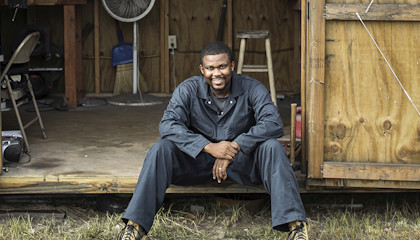A passion for steel
Quintin Middleton is passionate about three things – faith, family and knives. On the last of these, he recently took the opportunity to follow his dream. The bladesmith is now delivering his handmade knives to top chefs around the world.

Quintin Middleton grew up in the American South in the 1980s and '90s. He remembers himself as a kid with a brick and a claw hammer, pounding whatever scrap metal he could find into crude blades and sharp instruments.
"I just wanted to make swords like I'd seen in the movies," he recalls. "That's when my passion for making knives began."
Since then, and largely on his own, Middleton has learned the ancient art of bladesmithing. Jason Knight, a friend and fellow bladesmith, provided hints, as well as local chef Craig Diehl who explained what a professional chef looks for in a knife. Armed with this knowledge, through trial and error, as well as feedback from Diehl, he delivered a prototype of the high-quality product he's known for.

Middleton Made Knives offers a variety of boning and paring knives, and Santoku and Damascus chef knives. While his chef knives sells for 800 US dollars or more, Middleton remains true to his roots, offering products for as little as USD 80 – knives "even a line cook can afford," he says.
Middleton still uses a hammer and forge for some of his work, but he also uses an alternative process called "stock removal." For this he has selected 3 millimeter thick Sandvik 13C26 strip, a stainless steel grade recommended for surgical knives and razor blades.
"Stock removal means cutting out the design instead of hammering it into shape. After sketching the rough profile directly on the sheet, I bandsaw, grind, and heat-treat to 1,950 degrees Fahrenheit [1,066 degrees Celcius]. Then I quench between two aluminum plates, leaving the steel at around 61 Rockwell [a metallurgical hardness scale]."
Again, Middleton figured most of this out on this own. "I found the Sandvik material through online research and talking to other knife makers," he says. "13C26 has a very fine grain structure, so I can sharpen it to a very fine edge, without any of the micro cracks you see in other steels. It's also very hard, but remains tough after heat-treating. It holds up better than anything else I've found."
From humble beginnings, it looks as if this self-described "country boy" is well on his way.
Biography
Quintin Middleton lives in St. Stephen, South Carolina, with his wife and two children. Born in 1985, Middleton began teaching himself the art of bladesmithing from an early age. He recently left his employment as a handyman and now pursues his passion for making knives on a full-time basis. He sells knives to chefs around the world through www.middletonmadeknives.com.